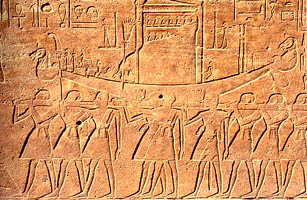
Beautiful Feast of the Valley
Hab Nefer en Painet

Amun's shrine carried in a procession by priests; from Hatshepsut's
temple at Deir el-Bahari, in Guide to the Valley of the Kings
The Beautiful Feast of the Desert Valley, or Hab Nefer en Painet, was an annual festival in Thebes that dates back at least as far as the Middle Kingdom. Its origins as a folk festival may reach further than that, but during the Eleventh Dynasty, Pharaoh Montuhotep II built a mortuary temple in the desert valley west of Thebes as a focus point for the celebrations. That particular area, not far from what later became the Valley of the Kings, was considered sacred to Hathor in her funerary role as Lady of the West. Early in the New Kingdom, Pharaoh Hatshepsut had her famous Deir el-Bahari temple complex built alongside that of Montuhotep as a grand expansion to the Hab Nefer en Painet.
The Feast of the Valley was essentially a celebration of the dead. It was observed during the second month of Shomu, the summer season. On our modern calendar, that would occur sometime in mid-May. During the festival, which lasted several days, the statue of Amun (later Amun-Ra) in Karnak temple was placed in a portable shrine on a miniature boat (called a barque) and carried in a grand procession, similar to the Opet festival. The main difference was that in the Valley festival, Amun's procession crossed the river from east to west to visit mortuary temples on the opposite bank. This journey was symbolic; east was the direction of the living, where the rising sun was born anew each morning. West, the direction of the setting sun, was the land of the dead. Amun-Ra, through his oracle statue, travelled to the west to pay his respects to the blessed dead and to Osiris, "Foremost of the Westerners".
Following Amun-Ra's sacred barque, which was carried by priests, were the people of Thebes. The parade was probably a raucous, jubilant event not unlike modern feast days in Mexico and South America, as well as Mardi Gras. Townspeople would bring flowers and offerings before Amun's shrine to be blessed, then would bring those offerings across the river to their ancestral tomb chapels. Families would spend time at these chapels, having a meal in the company of their departed loved ones and receiving friends who stopped to pay their respects. (This practice is also mirrored in modern times by All Soul's Day, or Dia de los Muertes in Mexico.) Another aspect of the Hab Nefer en Painet was ritual drunkenness. The Egyptians believed that a drunken state, as well as other altered states of consciousness, brought one closer to the gods and the blessed dead. Many parts of the Feast of the Valley, as with modern holidays, probably included heavy drinking!
Amun's shrine crossed the Nile in a barge called the Userhat, or "Powerful Prow", which was towed by the pharaoh's personal ship. It disembarked and the procession, led by the pharaoh, continued down a long valley causeway marked with a rest station where priests set the sacred barque down temporarily. On the east bank in Karnak, townspeople could bring offerings before the god or ask questions while the shrine stopped at a barque station; once Amun's retinue crossed to the west side, however, the procession became off-limits to commoners. In temples such as Hatshepsut's, called the Djoser-djoseru or "Holy of Holies", entry was reserved only for priests and high-ranking officials; access to her own ancestral memorial chapel was even more restricted. Evidence has been found, however, of bricks lining the causeway of the Djoser-djoseru that were dedicated by ordinary citizens. By donating inscribed bricks they could participate in the state procession by proxy.
While the townspeople went on to visit their own family chapels, the shrine of Amun-Ra was brought into the heart of Djoser-djoseru and left overnight. This was considered a sacred period during which the bond between Amun-Ra, king of the gods, and the pharaoh, king of the people, was reaffirmed. The following morning, the procession began again as Amun-Ra was taken to mortuary temples of earlier pharaohs, including Montuhotep, who were identified with Osiris. Later in the New Kingdom, the procession probably grew longer and longer as more temples were added by successive kings. At the end of the festival period, Amun-Ra's barque was brought back to the temple at Karnak and his statue placed back in its permanent shrine. The statues of his consort Mut and son Khonsu, which were taken out to participate along with Amun, returned to their respective shrines in Karnak as well.
The Beautiful Feast of the Valley, like many other religious festivals, was greatly disrupted during the Amarna period. We can only imagine the relief and jubilation of the citizens of Thebes as the young Pharaoh Tutankhamun led his first procession in the Hab Nefer en Painet, probably in Year 3 of his reign after the capital was returned to Thebes from Amarna. Unfortunately, after his death his own mortuary temple probably only received visits from Amun-Ra for a short time before it was usurped by his successors. But his subjects who outlived him probably remembered him with gratitude, until it was their turn to be honored along with him in the Beautiful Feast of the Desert Valley.
References:
Roerig, Catharine H. et al. Hatshepsut: From Queen to Pharaoh. New York: Metropolitan Museum of Art, 2005. pp. 182-183, 270.
Siliotti, Alberto. Guide to the Valley of the Kings. New York: Barnes and Noble Press, 1997. p. 111.
Back to Temple Main Page